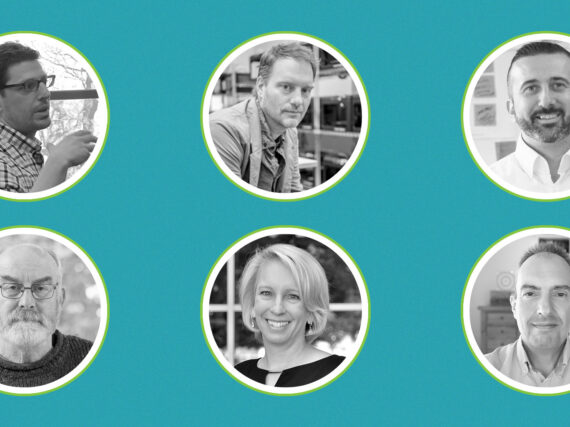Do you ever feel like the day flies by and you must have done a lot because you were really busy, but you didn’t get a lot done? Even more so when working at home, with the distractions that can pop up, it might feel like the time is slipping by, but your best work isn’t getting done.
We’ve all been there. Along the way, I’ve learned some techniques that help prioritize activities and focus efforts so we put our best work into the most important areas. It all starts with goal setting. Goals help us prioritize. They show us what we can let go of, and where we can dive deeper. They help us keep perspective.
My goal-setting journey began in earnest when a few of my colleagues at GovWebworks took on the challenge of introducing our team to Kaizen, a process of continuous analysis and improvement popularized by the successful Toyota Production System in Japan. We designed a year-long roadmap to dig into a new theme each month that would bring benefit to our organization. One thing became clear, being able to set goals and actually achieve them was going to define how well we achieved results with Kaizen. We decided to make goal setting our first topic and do research on best practices as well as reflect with others on how we had been successful in the past.
As a result of our efforts, we found the following techniques to be the most useful. They give us an edge in realizing our organizational objectives, all while helping us do less unfocused work. We hope these tips will do the same for you and your organization.
First, define high quality goals
First things first, how do we come up with a quality goal that’s going to last? One thing we’ve found is that the quality of the goals we set are a good indicator of how likely we are to successfully accomplish them.
There are a couple properties of high quality goals that make them more likely to be successful. They should be both inspiring and achievable. Too much of one without the other is a recipe for a goal that isn’t likely to see success, no matter how good our intentions are.
The technique we like to use here is breaking a Big Goal down into Achievable parts. When we say a Big Goal, we mean what Jim Collins and Jerry Porras called a BHAG (Big, Hairy, Audacious Goal) in their book Built to Last: Successful Habits of Visionary Companies. The BHAG is where you find your inspiration. These are goals where the value is apparent, the outcome is compelling, and the prospect is a little scary. These goals are life changing. But as we mentioned, a Big Goal without some level of achievability is not likely to find success.
This is where we can employ the SMART framework to break down our Big Goal into a set of smaller Achievable Goals. SMART is an acronym for:
- Specific
- Measurable
- Achievable
- Relevant
- Timebound
It’s these properties we want to stress when breaking down a set of steps to achieve an inspirational goal. “When short-term tasks feel trivial, lumping them into a larger goal makes them meaningful,” says Adam Grant, an author and organizational psychologist at Wharton. “When long-term goals feel impossible, slicing them into smaller pieces makes them manageable. Zoom out for purpose. Zoom in for progress.”
For example, one of my goals is to write a book. While this is an inspiring goal for me, it needs to be broken down into smaller do-able parts to feel achievable.
Next, match your goals to values
Having high quality goals is a good first step, but to really make a goal last for the long haul, we’ll want to dig a little deeper into why the goal is important. By identifying why our goals are important to us, we give ourselves a better chance at weathering the resistance when we face the decision to give up or keep going. An effective method we’ve found for uncovering why our goals are important is to match goals to values.
If my BHAG is to write a book, I’d certainly do well to read more consistently. That goal is worthy and admirable on its own, but I can add some muscle to the mix by spending a little time considering how it fits into my bigger picture. For me, I would say that consistent reading aligns with an image I have of myself as a lifetime learner in my personal life, and a servant leader at work. We all know the temptation to let Netflix auto-play us into a binge session of Stranger Things rather than finish a chapter we’re reading. I try to consider not just how abandoning the chapter will affect me, but how it affects commitments I’ve made to my team to share what I’ve learned from my reading.
In this vein, I use the same techniques with my teams at work. Maybe there’s a team goal of writing more automated tests for the source code. Most will agree that’s a great goal but sometimes schedule pressure or feature envy will entice a team to shortcut the test writing process. This is a great opportunity where a team can have an upfront conversation as part of the goal setting process to identify why the team feels automated tests are important. The following benefits might emerge:
- Team Flexibility – with automated tests, new developers can make changes without worrying about unknowingly breaking something.
- Agility – teams can rework and refactor common areas of the code quickly and easily if they know it will be tested.
- Reliability – even if other systems or environments change, tests assure that the code is still functioning properly.
With an enumerated list like this in hand, the trade-offs are a lot more transparent when the team considers breaking a goal. We might find ways to justify cutting corners for ourselves, but when we think about how those same decisions affect others it provides incentive to stick to the plan.
Then, align your systems to your goals
The last step is to come up with the systems that make your goals automatic. This happens once you have high quality goals and you’ve beefed them up by matching them to your values.
- Running a marathon is a goal, training to run a marathon by running X miles each week is a system.
- Delivering a complex software system is a goal, having effective standup meetings every day to maintain team accountability is a system.
- Writing a book is a goal, writing regularly at a certain time every morning is a system.
It’s definitely possible to achieve goals without systems, but having a great system in place makes reaching your goals almost a byproduct, and might even put you on a trajectory to achieve the goals you haven’t considered yet.
The problem with systems, which is also one of the great things about them, is they are optimized to the results they deliver. If you are achieving sub-optimum results in areas of your life or business, there is a system you are following, whether intentionally or not, to achieve those exact results.
If you are overweight, you have a system that has produced those results. If you are running a department that is struggling with high turnover, there is a system that is producing those results. The key is to align the system to the goals you want, and disable or modify the systems that are producing the results you don’t want. Simple, right? Well, not exactly. It takes some practice.
In his book, The Power of Habit: Why We Do What We Do in Life and Business, Charles Duhigg discusses using existing habits to trigger new behaviors. Looking over your typical day, both your home life and your work life, you can probably identify some keystone events that happen every day. You wake up and get out of bed, you drive to work, you arrive at work and log into your computer, you return from lunch, you pack up to head home, you arrive home, etc. Each of these are points where you can concisely inject new behaviors that support your goals. We call these repeated behaviors systems.
Put it all into action
Start where you are. You probably already have some persistent habits you can use as triggers to plug in the behaviors you want to use to build towards your goals. For my goal of writing a book, this might include the following. Set the alarm for an hour earlier to write before the day begins. On the drive to work, listen to a podcast on a subject I need to write about. Upon arriving at work, take a couple minutes before checking mail and logging into my chat system to create a bullet plan for the day so I can get my work done in a timely manner. Take a few minutes of my lunch break to review the writing I did that morning. The key here is that I can use existing behaviors to modify or replace my existing systems with systems that not only achieve my desired goals, but may give me many more related benefits as well.
Turning back to my previous example, what would it take to reinforce that daily reading habit? I could listen to an audio book on the drive to work. Maybe it’s only 15 minutes a day but that will add up and may inspire some additional behavior tweaks.
I would also recommend making changes that are easy to start. For me, a nightly reading habit in place of an extra episode on Netflix was easier when I started with a book that was really interesting and easy to read. I didn’t chose something difficult and technical because I was trying to give myself the best shot at changing momentum. Once I had the new habit going pretty well it was easier to introduce less tantalizing reading options. By then, Netflix no longer felt like a competing option.
Once a little momentum builds we start to see positive results from our Achievable Goals. All of a sudden the Inspirational Goals seem more realistic. This momentum leads to more commitment to the Systems we’ve put in place. Altogether, we find a virtuous cycle starts to form.
So, to put it all together, here’s my BHAG broken down into parts:
- Inspirational Goal: Write a book.
- Achievable Goal: Create six blog entries this year.
- Actions:
Today: Choose a topic for first blog post (1 hour).
This week: Write first draft of article (8 hours).
This Month: Set up blog site or identify an existing blog to publish the post. - System: Write and read regularly to practice writing and make it a daily habit.
And now with the publication of this blog post, I’ve already made it through one round of tasks to create the first of those six blogs. Hurrah!
Finally, let go of what you don’t need to do anymore
As Ray Dalio, author of #1 New York Times Bestseller and #1 Amazon Business Book of the Year, Principles, says, “You can do almost ANYTHING but you can’t do EVERYTHING.”
Two of the biggest misconceptions about goal setting is that it means more work, or leads to disappointment about not being able to achieve everything you hoped. The irony we’ve found is that effective goal setting usually allows you to do less by focusing your efforts on what you really do want to achieve. It also removes the disappointment of not achieving everything because unrealistic expectations are removed.
Say we had five things we hoped to get done today, but only had time for three. How did we decide which three? Do the two that weren’t complete get added to a perpetual to-do list, or just get lined up for an even bigger list for tomorrow? This is where a well defined set of goals can help us let go of some of the items. If they aren’t contributing to our Big Goal, are they still something we need to do? Can we drop them into a list of things you are never going to do because the Big Goal is so important it’s worth making some sacrifices for?
The beauty of that list of Never-Going-To-Do items? We can stop worrying about it. It’s not a list of failures, it’s a list of noble sacrifices for a bigger cause that aligns with our values and is worthy of our energy.
Learn more
- Organizing Techniques That Actually Work: How a few good organizing techniques can help you get your most important things done, by Kevin Ferguson
- Motivation Techniques That Actually Work: Where and how to find the motivation to lift your performance to the next level, by Kevin Ferguson
- Kaizen Techniques That Really Work – White Paper: Planning strategies that can transform you and your organization through continuous improvement, by Kevin Ferguson







